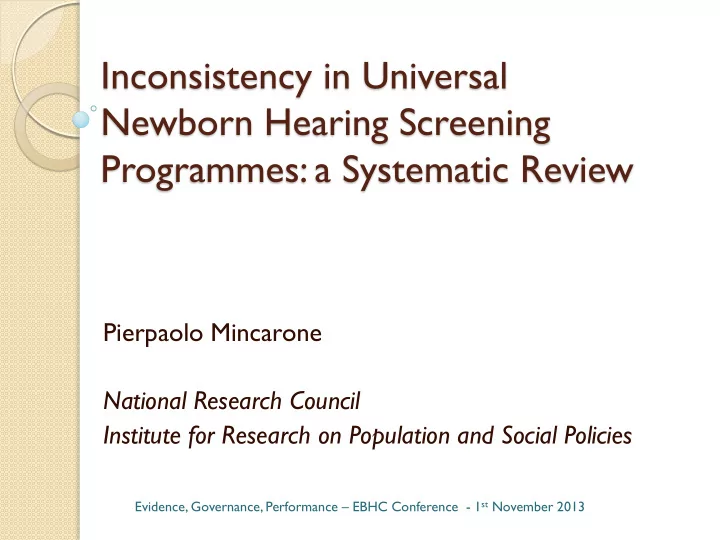

Inconsistency in Universal Newborn Hearing Screening Programmes: a Systematic Review Pierpaolo Mincarone National Research Council Institute for Research on Population and Social Policies Evidence, Governance, Performance – EBHC Conference - 1 st November 2013
Background HL, most frequent permanent congenital defect (Fujikawa et al. 2000) – conductive / sensorineural Risk factors for HL (most recent def.: JCIH, 2007) Prevalence of HL in newborns: ◦ 2 - 5% - at risk (Norton et al. 2000) ◦ 0.1 - 0.3% (Mehl et al. 2002) Tests: TOAE / aABR No newborn screening ◦ diagnosis at ≈14M (Erenberg et al. 1999) ◦ impaired language and learning (Rach et al. 1988) & increased behaviour problems, decreased pychosocial well-being, and poor adaptive skills (Davis et al. 1999)
Background US National Institutes for Health (NIH, 1993) , American Academy of Pediatrics (AAP) (Erenberg et al. 1999) , Joint Committee on Infant Hearing (JCIH, 1994) recommended universal screening and detection of newborns with hearing loss ≤3M , and intervention ≤6M The AAP and JCIH recommendations (most recent: JCIH, 2007) Universal Newborn Hearing Screening (UNHS) programmes worldwide and include indicators and benchmarks for process quality assessment
Aims State of Art : children with HL identified through UNHS • obtained better language outcomes at school age than those not screened (Nelson et al. 2008) • had significantly earlier referral, diagnosis and treatment than those not screened (Wolff et al. 2010) AIM : to evaluate published UNHS programmes using the AAP and JCIH benchmarks
Methods Systematic search UNHS programmes. Exclusion Criteria: ◦ non-English, no protocol description, equivocal assignment of results to the protocols, no false positive Data Extracted: ◦ study design, duration, starting year ◦ participants (#neonates, #screened, #at higher risk, risk assess.) ◦ protocol (tests, audible threshold, uni- vs. bi-lateral HL, timing, environmental test conditions, personnel) ◦ quality indicators
Methods Quality indicators and benchmarks (1/2) Follow-up rate ≥95 % 2 UNHS Program + + Scr <disc Scr >disc Diagn F+ T+ % newborns compleeting screening ≤ 1M ≥95% 1 Recruitment and Adherence
Methods Resource Consumption Quality indicators and benchmarks (2/2) % Ref. at discharge 5-20% (OAE) % Ref. def. aud. eval. 4% (ABR) <4% False-positive rate ≤3% UNHS Program + + 6 5 Scr <disc Scr >disc Diagn 7 F+ T+ Clinical 4 Effectiveness 3 HL Prevalence 2-5% (Risk) % def. aud. eval . ≤ 3M ≥90% 0.1-0.3% (All)
Benchmark not achieved; Benchmark achieved Results Measured prevalence above literature data Measured prevalence under literature data Source T est Audiol. Risk HL Extent Performance Indicators Assess. Recruit. and Clinical Resource [Type; N.] Adherence Effectiv. Cons. OAE 40dB HL Bevilacqua M, □ JCIH 2007 2010 2 unilateral OAE 40dB HL Watkin P, □ □ □ - 1996 2 bilateral OAE 40dB HL Aidan D, □ □ JCIH 1990 1999 2 unilateral OAE 26dB HL Habib H, □ □ □ JCIH 1994 (NICU) 2005 2 unilateral OAE - Lin H, □ □ □ - 2007 2-3 unilateral OAE 40dB HL Korres S, □ □□ □ - 2008 3-4 unilateral OAE Specifically - Tatli MM, □ □ □ 2007 2 reported unilateral Both 40dB HL Kennedy C, 2005 □ NIH, 1994 - Wessex, 1998 2 bilateral Both - Lin H, □ □ □ - 2007 2 unilateral
Benchmark not achieved; Benchmark achieved Results Measured prevalence above literature data Measured prevalence under literature data Source T est Audiol. Risk HL Extent Performance Indicators Assess. Recruit. and Clinical Resource [Type; N.] Adherence Effectiv. Cons. Both 40db HL JCIH 1994 Calevo M, 2007 4 unilateral Both 30dB nHL De Capua, JCIH, 2000 2007 3 unilateral WBB: 35dB HL ABR Barsky-Firkser L, □ □ □ JCIH 1994 NICU: 40dB HL ( NICU) 1997 1 bilateral (NICU ) ABR ASHA 1988; 35dB nHL Mason JA, 1998 1 ASHA 1989 bilateral (all) (NICU ) ABR ASHA 1988; 35dB nHL Mason JA, 1998 2 ASHA 1989 bilateral (all) ABR - Lin H, □ □ □ - 2007 2 unilateral ABR 35dB HL Tsuchiya H, □□ □ □ - 2006 2 unilateral ABR Admission to 35dB nHL Clemens CJ, □ □ 2000 2-3 NICU unilateral
Limits Quality indicators and benchmarks established and updated by the AAP and JCIH since February 1999 while most of the studies initiated or concluded recruitment prior to that date we tested feasibility of performing standardised evaluations of UNHS programmes Articles only in English 9 / 14 studies in our review from non-English-speaking countries
Bottom line Our systematic review substantial variability , incomplete reporting and performance gaps , in the scientific literature published to date Need to optimise reporting of ◦ screening protocols and ◦ process performance Future research: ◦ assessment of long-term outcomes of neonates with negative screening tests ( false negative ) ◦ causes for and interventions to reduce lost to follow-up ◦ standardisation of recommended quality indicators
Bottom Line This research was possible also thanks to Carlo Giacomo LEO Saverio SABINA Daniele COSTANTINI John B WONG Giuseppe LATINI Pierpaolo Mincarone pierpaolo.mincarone@irpps.cnr.it
Recommend
More recommend